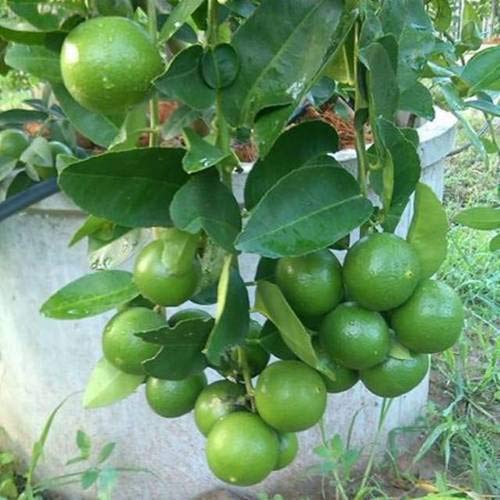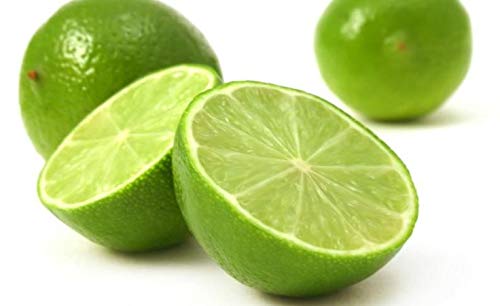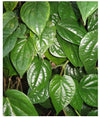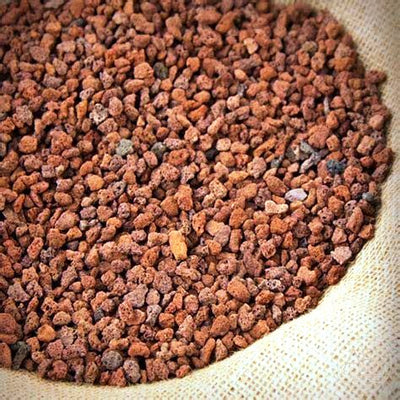


Green Paradise Offers Healthy Kagzi
Lemon Plant
About Kagzi Lemon Plant
Kagzi Lemon is a small evergreen tree that belongs to the Rutaceae family. It is native to Southeast Asia, but it is now cultivated in various tropical and subtropical regions around the world for its edible fruit. The tree is known for its aromatic leaves and small, round, greenish-yellow fruits.
Here are some key characteristics and information about the Kagzi Lemon plant:
Appearance:
-
The Key lime tree is a compact, thorny tree that can reach a height of about 10 to 20 feet (3 to 6 meters) in ideal conditions.
-
It has small, ovate to elliptical, glossy leaves that are deep green in color and emit a citrusy fragrance when crushed.
-
The tree produces fragrant white flowers with five petals.
Fruit:
-
The Kagzi Lemon fruit is small, round, and typically 1 to 2 inches (2.5 to 5 centimeters) in diameter.
-
When mature, the fruit is greenish-yellow in color and has a thin, smooth rind.
-
The pulp is juicy, acidic, and highly aromatic.
-
It is known for its distinct flavor, which is more tart and acidic compared to other citrus fruits.
Culinary Uses:
-
Key limes are widely used in culinary applications, especially in tropical and Mexican cuisine.
-
They are a key ingredient in famous dishes such as Key lime pie, ceviche, marinades, and various beverages.
-
The juice is highly acidic and adds a tangy flavor to recipes.
Growing Conditions:
-
Kagzi Lemon thrives in warm, tropical or subtropical climates.
-
It prefers full sun and well-draining soil.
-
The tree is sensitive to frost and requires protection in colder regions.
-
It can be grown in holders or planted in the ground.
-
For optimum growth, regular fertilization and irrigation are required.
Propagations:
-
Kagzi Lemon can be propagated through seeds, but the resulting plants may not retain the exact characteristics of the parent tree.
-
Grafting or budding is a more common method of propagation to ensure desirable traits and fruit quality.
-
It takes several years for the trees to bear fruit.
Medicinal and Other Uses:
-
Kagzi Lemon have been used in traditional medicine for their potential health benefits.
-
They're rich in vitamin C and antioxidants.
-
Fruit and juice are often consumed to boost immunity, aid digestion, and support overall health.
-
Additionally, the essential oil extracted from the peel is used in perfumes, soaps, and other cosmetic products.
Cultural Significance:
-
Kagzi Lemon have cultural significance in regions where they are grown.
-
They are often associated with tropical landscapes and are considered iconic in Florida, particularly in the Florida Keys, where Key lime pie originated.
While Kagzi Lemon is primarily grown for its fruit, the tree also serves as an ornamental plant in gardens and landscapes due to its attractive foliage and fragrant flowers. It requires regular care, including pruning, pest control, and appropriate nutrient management, to ensure healthy growth and fruit production.
How To Grow Kagzi Lemon Plant
To grow a Kagzi lemon plant, also known as Kagzi lime, you can follow these steps:
Obtain a healthy sapling:
-
Purchase a Kagzi lemon sapling from a reputable nursery or garden center.
-
Ensure that the sapling is healthy, with a well-developed root system.
Choose a suitable location:
-
Kagzi lemon plants thrive in full sunlight, so select a location in your garden that receives at least 6-8 hours of direct sunlight per day.
-
The soil should be well-draining and slightly acidic with a pH position between5.5 and6.5.
Prepare the soil:
-
Before planting, prepare the soil by loosening it and removing any weeds or jewels.
-
You can also enrich the soil by adding organic compost or well-rotted manure to improve its fertility and drainage.
Dig a planting hole:
-
Dig a hole that is twice the size of the root ball of the sapling.
-
Make sure the hole is deep enough so that the top of the root ball is level with or slightly above the soil surface.
Plant the sapling:
-
Gently place the Kagzi lemon sapling into the hole, ensuring that the root ball is positioned properly.
-
Backfill the hole with soil, indurate it gently around the base of the factory to remove any air pockets.
Water thoroughly:
-
After planting, water the sapling thoroughly to settle the soil and provide initial moisture.
-
Maintain a constant moisture but avoid drowning the soil.
-
Water the factory regularly, especially during dry spells or hot rainfall.
Mulch the soil:
-
Apply a layer of organic mulch, such as wood chips or compost, around the base of the plant.
-
Mulching helps retain humidity, suppresses weed growth, and regulates soil temperature.
Fertilize regularly:
-
Feed your Kagzi lemon plant with a balanced citrus fertilizer or a slow-release fertilizer specifically formulated for citrus plants.
-
Follow the package instructions for the application rate and frequency.
Prune and shape the plant:
-
As the plant grows, you can prune it to maintain a desirable shape and encourage branching.
-
Before new growth starts, pruning can be done in the late winter or early spring.
-
Remove any dead, diseased, or crossing branches to improve airflow and overall plant health.
Pest and disease control:
-
Monitor your Kagzi lemon plant for common citrus pests such as aphids, scales, and citrus leaf miners.
-
If necessary, use appropriate organic or chemical treatments to control pests.
-
Watch out for signs of diseases like citrus canker or citrus greening and take prompt action if you observe any symptoms.
Harvesting:
-
Kagzi lemons are usually ready for harvest when they turn yellow.
-
They can be picked when fully ripe and used for culinary purposes or squeezed for juice.
Remember to provide regular care, including watering, fertilizing, and pest control, to ensure the healthy growth of your Kagzi lemon plant. With proper attention and care, you can enjoy a bountiful harvest of delicious Kagzi lemons.


















